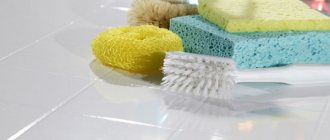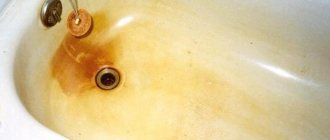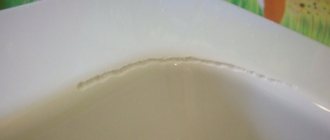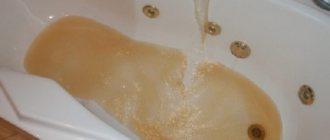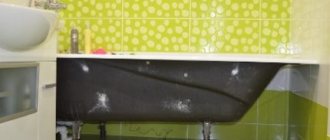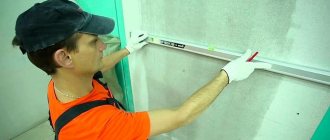The final stage of laying wall or floor tiles is to apply grout to the joint area. This process is mandatory as it creates the finished appearance of the coating.
If you are looking for beautiful and reliable tiles for walls and floors, then welcome to the Kerama Marazzi store (Moscow, Budyonny Avenue, 27). Here you will find a large assortment of high-quality tiles and porcelain tiles. You can view samples on the website of the company TILES FROM THE FACTORY. Based on the type of room and interior style, you can choose matte or glossy tiles.
Does old grout need to be replaced?
The need to replace old grout may arise for at least several reasons:
- You have decided to change the design somewhat and choose a brighter, or, conversely, less shade for the joints in order to emphasize the originality of the tile. Quite often, this method is practiced in cosmetic repairs without changing ceramics, which allows you to create literally new conditions.
- The reason for replacing the old grout is its deterioration, which occurs due to insufficient quality and imperfection of the material processing technology. For example, porcelain stoneware is obtained by firing it in a kiln at more than 1000 degrees, which cannot be done with grout.
- The work on tiling the walls was carried out poorly, as a result of which the material was damaged and began to have an unsuitable appearance.
- Sometimes it becomes necessary to partially or completely replace the tiles, and then the grout is completely removed.
To seal the seams between the dies with a new fugue or other similar material, it is necessary to remove the old one from it. This is necessary in order to ensure a stronger retention of fresh material.
To understand how to remove old grout from tile joints in a bathroom or kitchen, you should first become familiar with all types of materials that are used to seal joints. They are roughly divided into the following varieties:
- Cement-based is the most inexpensive and common type of joint sealer. It has good water-repellent properties, but without special water-repellent components it cannot be used for bathrooms. It is in this type of grout that mold most often occurs if it was chosen incorrectly and not applied according to technology.
- Epoxy-based is a special type of high-strength decorative materials that perfectly protects tiles and walls from getting wet. It is insoluble in water and has a resinous structure.
- Silicone is a highly effective type of joint sealing material that is used to seal surfaces that are in regular contact with water. They do not form cracks, maintain tightness and provide an attractive appearance.
For each of the listed types of materials, a different product is used to seal the seams between ceramics and porcelain stoneware, because today there is no universal one.
The fact is that they have their own specific properties and have a unique composition, and therefore will interact with different substances in different ways.
For example, silicone is dissolved by vinegar, but cement compositions do not change in any way under its influence.
We also recommend watching - Grouting tiles in the bathroom: types, how to choose and use
Cleaning fresh grout
If the grout is fresh (no more than a day has passed since it was applied), then it can be easily wiped off by soaking it with water.
- 30 minutes after applying the grout, remove excess and sand the joints using a clean, damp sponge. If you often do tiling work, there are special buckets with rollers for squeezing foam rubber. This was previously mentioned in the article about tiler tools.
- The next day you need to remove the white coating using a felt mitten. There are also special graters with felt, but they will not wipe the relief tiles well.
Convenient bucket for cleaning grout floors with rollers for squeezing the sponge
If after grouting you find unevenness, but it has already hardened, it will be enough to walk along the seam with fine sandpaper rolled into a tube.
Sometimes it happens that the tiles have a very large relief and a lot of decorative elements. When grouting it, it is advisable to seal the surface with masking tape and plastic film in advance. But if the grout has already become embedded in the texture of the tile, you can wash it using a terry cloth moistened with sunflower oil.
Individual protection means
To safely remove grout and various grouts from the joints between tiles, you must first of all follow safety precautions.
This is an important point, because means for softening hardened compounds are quite caustic and chemically active.
If it comes into contact with the skin, it can cause irritation and discomfort, not to mention allergic symptoms. Therefore, when starting work on removing old mortars and other putties from the joints between tiles, it is necessary to use personal protective equipment. These include:
- Rubber gloves are the main protective accessory that will protect your hands from all kinds of negative reactions from acids and alkalis. Thin medical ones may not be useful when working with some types of drugs.
- A mask or respirator is an especially important accessory if work is performed in a dry, mechanical manner. In this case, a lot of dust is generated, from which you need to protect your respiratory organs.
- Workwear is an element of personal protection that will protect against contamination generated during work. This also includes shoes.
Preparing for work
Before starting work, clear the room as much as possible. All furniture and equipment that cannot be removed are covered with film or rags. To protect the flooring from scratches, old newspapers are laid out in several layers next to the walls, and the surface of the baseboards is covered with masking tape. Important!
Be sure to prepare personal protective equipment. To prevent grout crumbs from getting into your eyes, wear plastic glasses. To protect against silicate dust, use a respirator or a regular gauze bandage. Protect the skin on your hands with thick rubber gloves. Open areas of the body are covered with clothing.
Work begins by wiping the tiles with warm soapy water. This will help fill the tile with moisture, remove dirt and protect the edges of the ceramic coating from accidental chipping. Then tap the tile with a rubber hammer to find out if there are any voids underneath. If such are found, a mechanical method cannot be used to remove the old grout from the tile joints. It will lead to destruction of the cladding and the need to completely remove the tiles.
Softening compounds
Depending on the technology and materials, there are 2 ways to remove grout from the seams of wall or floor coverings:
- Mechanical is an effective method, but very labor-intensive. To remove grout from the joints between tiles, you will need the appropriate tools. This can be a spatula, a scraper, and in some situations a screwdriver helps. But for high-quality and quick removal of the composition, it is better to use a universal tool with attachments: various spatulas, scrapers and other devices. For ease of work, it is recommended to use a vacuum cleaner.
- Chemical is a reliable method for removing grout joints. They are various liquid or semi-liquid, gel-like compositions, which, as a result of a certain chemical reaction, literally dissolve the fugue, soften it, making it elastic and pliable, then it still needs to be removed mechanically. Therefore, this method is also called combined.
If everything is clear with mechanical procedures, then with chemical procedures the situation is a little different. Such materials, due to their active formula, literally dissolve solid mixtures, forming a soft or liquid mass, which is then quite easily removed from the seam mechanically.
It is important to know! If epoxy resins were used to seal the seams between the tiles, then it is better to entrust the work of removing it to experienced craftsmen, since after drying such materials become hard as stone.
If you nevertheless decide to use mechanical methods for removing grout from the seams of tiles or porcelain stoneware, then there are several types of reagents on sale that effectively affect the grout:
- Products for cement grout – Valo Clean . A highly effective solvent that has a significant effect on various types of cement compositions. It is usually used if mold has formed in the seams and fungus has developed. The composition has strong antiseptic and disinfecting properties.
- Keranet are special types of acid-based chemicals that are used to dissolve grout, mainly on ceramic tiles. The acid is a dry powder with a high concentration of the active substance, and is also sold in the form of a liquid solution prepared on the basis of organic acid.
- Litostrip is a special active substance that is used to effectively remove epoxy-based grout. They provide a high degree of purification and quality removal of the mixture from the joint. The principle of working with the solution is as follows: the composition is stirred and applied to the seams, after leaving for a certain time it is removed mechanically using a spatula.
It is important to know! When deciding to purchase an organic acid to remove grout, keep in mind that it is not recommended for marble, natural stone, or glazed ceramics. The substance may cause damage to decorative coatings.
Why remove the grout at all?
First, you should decide for what purpose you will clean the seams. This is very important because the selection of tools will largely depend on the option chosen.
- Restoration of seams due to improper installation of tiles or joints.
- Updating outdated seams.
- The joint between the tiles is affected by fungus.
- The mixture was chosen incorrectly, the seam began to crumble.
There are three most common ways to clean the finished mixture:
- Dry cleaning with a cutting tool.
- Using a softener or solvent for the seams followed by cleaning with a tool.
- Use of antiseptic, softener and tools.
If you want to carefully remove the joints, points 1 and 2 are suitable for you. Well, if you decide to undertake a major renovation in the bathroom, then option number 3 is suitable. For the work you will need a small kit:
- a scraper or a sharp tool - a screwdriver, a small chisel, a knife, etc.;
- special construction chemicals for removing seams;
- hard coated sponge;
- sandpaper, scraper and anything suitable for fine cleaning of surfaces.
Now in more detail about each option.
Chemical composition
Each product for removing old grout from joints on a ceramic or porcelain tile has its own properties, which is determined by the components it contains.
It is important to perform all operations correctly so that no traces remain on the surface of the tile after the reagents themselves.
Therefore, we will consider the properties and composition of preparations for each type of fugue.
For cement-based grouts
For cement-based grouts, compositions are used based on organic acids. They are similar in their properties to hydrochloric or sulfuric acid, but are not dangerous to humans, since when interacting with other substances they do not emit acrid smoke or various fumes.
But still, when working with them, you should be very careful so that the composition does not get on your hands, as it can cause allergic reactions.
Suitable not only for grouts, but also for concrete and various adhesive mixtures. Before use, the contents of the bucket must be mixed with water and shaken thoroughly until smooth. Clutoclean and Litoclean Plus products have these properties.
Interesting to know! Do you want to save money, but grout removers are quite expensive? You can use the folk method using citric acid, vinegar and laundry soap. All this is mixed with water and applied to the surface that needs to be cleaned.
For epoxy compounds
Epoxy-based grouts are highly reliable and durable, which is good if the repair is done forever and bad when you want to change it. This is due to the natural physical properties of the resin, which hardens and becomes like stone.
The average service life of such joint sealing is usually at least 30 years.
To combat stains based on epoxy resins, it is recommended to use the product Litocol, you can also use the substance in the form of a gel. In fact, this drug is universal, as it is able to successfully dissolve fat, oil, foam, ink and wax.
The product is universal, as it can be used to clean grout from all types of tiles and is diluted to the required consistency with water. It is a concentrated alkaline solution.
For silicone sealants
To remove silicone grout from joints, it is necessary to use special potent preparations. There are many varieties of them on sale, all of them work approximately the same.
The most common effective actions include:
- Penosil Silicone R;
- Silicon-Entferner;
- Dow Corning OS-2;
- Antisil;
- Penta-840;
- Forch R551;
- R507.
All compositions for combating old silicone in the seams between tiles and in any other places contain acids. It is not without reason that it is present in many varieties, as evidenced by the characteristic smell.
It is important to know ! If the seams were filled with silicone sealant many years ago, then it can probably be dissolved with white spirit. This is an effective remedy, no doubt, but not for modern brands of silicones, because recent developments have become even more reliable and resistant to various chemicals. Only the materials described above can handle them.
Reasons for early wear of grout
The service life of ceramic coating on the walls of a bathroom, toilet or kitchen is quite long. But situations arise when the grout between individual tiles quickly loses its attractive appearance and ceases to perform the function of protecting against moisture. There are several reasons for the deterioration of the seams:
- Wrong choice of grout mixture without taking into account the purpose of the room, the level of humidity in it and the air temperature.
- Making mistakes when sealing the seam - with gaps or to a small depth.
- The prepared solution was too liquid. This reduces the final strength of the seams and makes them less durable.
- Using cleaning products containing acid to clean ceramic tiles, which destroys the material.
- Penetration of fungus into the space between the tiles and the formation of mold.
- Ineffective ventilation in the bathroom, which leads to increased humidity.
- Contamination of light-colored seams.
Treating cracks with steam and covering with a masking compound
In addition to chemical and mechanical methods of removing sealant from the joint between tiles, you can use hot steam. The fact is that silicone usually withstands temperatures up to 90 degrees, and steam is much hotter, so it has a destructive effect on sealants and effectively removes it.
In such a situation, you need to work as follows:
- Direct the steam stream to the area to be treated and hold for a few seconds. During this time, the sealant literally peels off from the base.
- Afterwards, using a hard-bristled brush and water, the material is removed from the seam with vigorous movements. Typically, exposure to a concentrated jet of steam occurs simultaneously with mechanical removal of the sealant, that is, special brushes are used.
If the place needs to be restored without removing the old grout, then cover it with a special pencil with a waterproof filler or cover it with a water-based composition.
Matte tiles
It is more difficult to remove grout from rough, matte tiles due to its structure. The composition gets clogged into the pores of such tiles, and can only be removed with abrasive agents. You can use regular baking soda. When using liquid compounds without abrasive particles, use a brush with coarse bristles.
Application of chemical reagents
Don't know how to remove old grout from ceramic tile joints? An effective method is chemicals. For each type of fugue, you need to choose your own cleaner.
Let's look at an example of using cement removers using Sopro ESE 548 solvent:
- First of all, you need to apply the composition and wait for at least 20 minutes.
- After the joint filler has softened, mechanical removal begins using a scraper or jointer.
- The separated fugue residues are removed with a wet rag or sponge.
After the surface has completely dried, you can begin filling the new composition.
If the seams were filled with a thick layer of silicone sealant, then a chemical agent, for example, Penta-840, is applied twice, after removing the top layer or most of it from the joint.
Useful tips
The following recommendations will help reduce the amount of cleaning after the renovation is completed:
- after grouting the seams, you need to wipe each tile with a wet cloth, this will reduce the amount of contamination;
- It is necessary to remove the remains of the fugue immediately after finishing the work, because after polymerization and adhesion to the tile, it will be more difficult to remove stains;
- It is better to cover decorative patterns on the tiles with masking tape, because it is sometimes impossible to remove the sealant that gets into them (if the grooves are too deep);
- When carrying out grouting work in rooms with high humidity, additional ventilation must be provided. If this rule is not followed, the cement composition may not dry out completely and will crumble over time.
It is better to remove grout from the tiles immediately after finishing the repair work. If the mixture has time to completely harden, the effectiveness of the available methods will not be enough, and you will have to buy special products.
Mechanical removal
Removing old grout from the joints between the tiles on the floor and walls causes a lot of hassle, because it is already a hardened material that has acquired its maximum strength. Therefore, you will have to work hard, especially if you decide to use a mechanical method.
This is an effective method, but without folk recipes and professional remedies, the process will take much more of your time.
Let's look at the most popular and accessible technologies using familiar tools:
Painting knife
The thin replaceable blade makes it convenient, but when working with cement compounds it quickly becomes dull, so you will have to buy as many replacement blades as possible. Press the tip of the blade firmly against the seam and move along it several times.
Seam opener
A special device for removing silicone and cement compounds from joints. It has a comfortable handle and a specially shaped blade, which is made of very durable hardened steel.
Engraver Dremel
An effective electric tool that can be used to remove various compounds from joints. Equipped with special attachments.
Screwdriver
When using drills that are suitable in size and design, they are ideal for removing old mortar from the seam, but for more comfortable work, it is still better to soften the composition so that it is easier to remove it and not damage the front side of the tile.
Other power tools
In addition to the listed power tools, a multi-purpose tool can be used to remove old grout. This is a device that is equipped with various attachments, including those for sewing seams.
In any case, when using such tools, you should be extremely careful not to damage the coating. Otherwise, you will have to re-lay all the tiles, which will be very expensive.
Many people are interested in the question of how to remove epoxy-based grout? In this case, the use of a purely mechanical method will be ineffective. To combat such grout, professionals use methylene chloride. This is an effective active substance, but it is very difficult to obtain such a reagent. Therefore, it is better to immediately contact specialized companies.
Cleaning raised surfaces
It is easiest to get rid of old grout mixtures from smooth tiles, but what if you have to work with tiles that have a rough, decorative or embossed surface? When time is lost after the repair and the excess grout mixture was not washed off in time, it is much more difficult to wash the solution, especially when it comes to textured and porous tiles.
It’s not hard to figure out how to remove grout from embossed tiles: the first assistant in this is moisture. If you can’t wash the tiles with plain water, then it’s time to use special gentle products intended only for cleaning difficult surfaces (SoproAH737 is considered one of the most popular). According to the instructions, the cleaner is applied to the tiled surface and removed with a soft short-bristled brush.
It is not recommended to use aggressive and abrasive substances, powder-type cleaners and strong chemicals, as they may erase the design or decor.
To remove white plaque, simple soap or gel detergents are also used.
Traditional methods
You can also use folk remedies to remove old hardened grout based on cement and silicone. The most popular include:
Vinegar
To prepare the solution, mix water and vinegar in a 1:2 ratio. Cover the required area with this substance, and after half an hour, remove with a sponge and rinse with water.
Glycerol
An effective household chemical that is diluted in a ratio of 1:3. Cover the area with it for an hour, then clean it with a plastic spatula and rinse with water.
White spirit or kerosene
Suitable for removing old silicone joint fillers. Ineffective against new materials.
Ammonia
Suitable for combating fungus or mold formations. Dilute like vinegar and apply to the damaged area for 20 minutes.
How to clean the grout between bathroom tiles at home
With daily cleaning of the bathroom, it will not be possible to achieve ideal cleanliness of the tile joints. This is due to the fact that they have a rough surface, into which dirt and moisture can penetrate. As a result, an optimal environment is created for the development of bacteria, fungus, and mold. This not only leads to a deterioration in the appearance of the tiles, but can potentially cause health problems (allergies, skin diseases, decreased immunity).
Methods for cleaning seams
You can clean the seams between the tiles in the bathroom using different methods, ranging from traditional methods to completely replacing the grout. Each method has its own advantages and disadvantages, and is used depending on the input conditions (degree and nature of contamination, material and color of the tiles, presence of ventilation, etc.)
Folk cleaning products
Traditional methods are good because you can use improvised means that are found in almost any home. You can also purchase them at affordable prices, which are lower than for special chemical compositions. For small blockages, they are no less effective.
Cleaning with soda
Soda can be used for all types of tiles, except marble, applied to seams whose surface is not covered with a decorative layer. Cleaning tile joints in the bathroom with soda solution is performed in the following sequence:
- Pour half a glass of soda, then add water little by little and stir until a homogeneous thick mass is formed.
Optimal consistency of an aqueous soda solution. - Using available means, apply the solution to the seams in a thin, even layer.
- In a separate container, create a vinegar solution in water in a 2:1 ratio.
- Pour the resulting mixture into a hand sprayer.
- Treat the seams with a soda slurry applied to them with a vinegar solution.
Soda cleaning process. - After the chemical reaction is completed, you need to wipe the surface with a soft, dry cloth or brush.
- Remove any remaining plaque or dirt with a brush, and then wipe the tiles dry.
Important! For cleaning, you need to use brushes of medium hardness so as not to damage the mirror or textured surface of the tile. When working, you need to use rubber gloves.
An equally effective composition for cleaning is a solution of soda in hydrogen peroxide in a ratio of 4:1. To increase the cleaning properties, it is permissible to add dishwashing detergents, which will easily degrease the surface and improve the adhesive properties of suture materials.
A mixture based on soda and hydrogen peroxide allows you to get rid of the following problems:
- darkening;
- fungus;
- mold;
- has a disinfecting effect (destroys some types of bacteria);
- unpleasant musty odors, including tobacco.
It is beneficial to clean surfaces with soda at home or in the office, since the solutions are safe and do not contain toxic substances. Allows you to whiten surfaces.
Ammonia
Cleaning seams with ammonia is easy. To do this you will need:
- dissolve 10 ml of alcohol in 2 liters of water;
- Spray the mixture onto the contaminated areas;
- wait 20 minutes;
- Wipe the joints with a soft, dry cloth or sponge.
As a result, not only will the surface of the joints be clean, but the original shine of the tile will also be restored. The solution will also help deal with bacteria and microorganisms.
Bleaches
The following chemicals are suitable for whitening:
- Comet;
- White;
- Sif;
- Domestos.
Attention! Bleach is used to remove blackness, discoloration, and dirt exclusively on white tiles. Colored tiles may lose color saturation, fade, or change shades.
You need to clean out dark deposits in the following sequence:
- Moisten the surface with water.
- Apply an even layer of bleach.
- Wait 10-20 minutes (depending on the type of product applied) until the chemical reaction takes place.
- Clean with a soft sponge or brush.
- Rinse the tiles with plenty of water.
When working with these drugs, you must use gloves and avoid getting them on exposed areas of the body.
Complex chemicals
Combined preparations (Cillit Bang, Vexa, Mildew Remover) are characterized by high chemical activity, as they are universal in use:
- cleansing effect;
- fight against bacteria, fungus, mold, microorganisms;
- deep penetration into the material.
Cleaning compositions are used as follows:
- The surface of the tile is moistened with water using a sponge/rag.
- Apply the cleaning agent to contaminated areas in accordance with the manufacturer's instructions.
- Wait 5-7 minutes.
- Rub off with a sponge or wash off the product along with the dirt from the surface.
Recommendations from experts
Remember, old hardened grout must be removed carefully so as not to damage the front surface of the tile. This can be done either mechanically or chemically, but it is important to choose the right compositions.
For example, substances based on organic acids can be used to remove cement fugues.
To combat silicone joint fillers, acidic substances are also used, which soften the composition, making it mushy.
It is important that when removing any type of grout, you must first take care of your own safety and use at least gloves and a mask, because acid preparations have a negative effect on the human body.
How to clean various stains
In order to clean the joints between the tiles as efficiently as possible, it is worth considering the nature of the pollutants that cover them. Let's look at how to deal with pollution of various origins.
After renovation
The method discussed above using soda and vinegar will help to clean the seams between the tiles after repair. After removing dirt, you will need to thoroughly wash the walls or floor with plain water.
Fungus
Medical alcohol removes mold deposits well. To clean the joints between the tiles from fungus, you just need to apply the product to the space between the tiles with an old toothbrush. After fifteen to twenty minutes, remove the alcohol with clean water.
From nicotine
To clean the grout from traces of tobacco smoke, you will first need to mix any washing powder with ammonia in a small container to form a thick paste. The resulting mixture will quickly remove yellow nicotine stains from the space between the tiles.
Removing rust
To clean the grout from rusty stains, you need to treat them with a two percent solution of oxalic acid. After fifteen to twenty minutes, thoroughly wash the cleaned surface. To achieve the best result, these steps will have to be done several times.
Important! It is better not to use this method when working with ceramics, so as not to damage the material. In such a situation, it is worth replacing the acid with a slurry obtained by mixing soda with water.
Old stains
If there are old stains on the grout that are useless to scrub off, you should paint over them with water-based emulsion. Just before applying it, you will need to thoroughly wash the surface and treat it with any antifungal compound.
How to whiten grout
Over time, the grout turns black. To return it to its original whiteness, you will need to treat the seams between the tiles with a heated solution of citric acid in water. To prepare it, you need to mix three liters of water with three packets of nutritional supplement. The exposure time is thirty to forty minutes.
Removing fresh putty
It is easier and more economical to remove fresh putty for joints between tiles, because the composition has not yet hardened and is very pliable. To do this, you need to have several sponges and buckets of water with you. Often wetting the sponges, the surfaces are carefully wiped so as not to damage the fugue already present in the seam.
It is necessary to carry out the procedure until no whitish spots are visible on the surface. The final wash is done after drying with detergent.
How to clean grout from tiles after renovation?
Cleaning tiles after grouting, when the seam has completely hardened, will help with cleaning agents, but you need to be prepared for their use. Following the instructions guarantees a good result. Main stages:
- Preparation. Wear rubber gloves, goggles and a respirator if caustic agents are used for cleaning. If possible, open a window indoors.
- Application of the solution. The cleaning agent is used spot-on, applying only to contaminated areas. You can use a sponge or brush with unnatural bristles.
- Expectation. Before removing the remaining mixture, you must wait 15-20 minutes for the cleaning composition to react with the fugue.
- Scrubbing. Take a sponge or soft brush and remove the compound from the tiles in a circular motion.
- Rinse the tiles with water to remove any remaining detergent and grout.
Overview of methods
How to remove epoxy resin
Epoxy resin dries completely within a day and is invulnerable to the effects of acid-base compounds. It is possible to remove traces of epoxy resin only with the help of highly active reagents. When using cleaners, you must follow a number of rules and properly prepare for the work. Read more here.
Preparation
The first preparatory step is to select and purchase a special softener that can remove epoxy resin residues. To complete the work, you also need to prepare a metal brush for processing the ribbed surface, protective gloves and a respirator.
Seam sealing
To prevent the cleaner from destroying the tile seams, it is necessary to close them while the stains are being washed off. Applying a thick layer of masking tape creates an obstacle for the solvent to pass to the seams. If the solution gets on the seam, you must immediately wipe it off with a rag or sponge.
Solvent
If the epoxy resin has dried, you need to treat it with a solvent and wait 10 minutes for it to soften. Then traces of grout are removed with a metal brush or scraper. When performing work, it is important to be careful and control the degree of pressure so as not to destroy the tiles or leave scratches on the surface.
How to remove fugu
You can remove the old layer of grout between the tiles using a paint knife. The principle of removing the fugue is to carefully run a knife along the seam several times without touching the edges. The pressure of the knife will cause most of the grout to fall out, after which you will have to pick out the remains. Instead of a knife, you can use a grinder, but this tool is best used only if you have practical experience. The need to remove the fugue arises when applying new grout.
